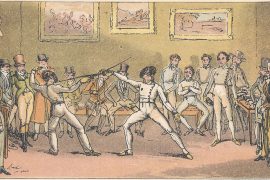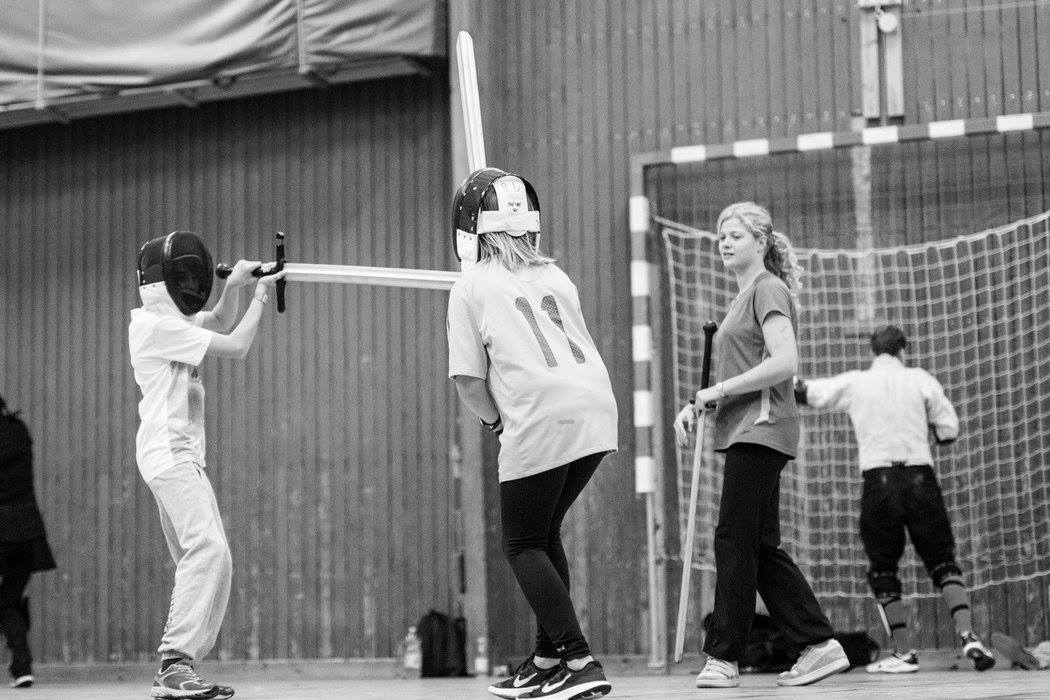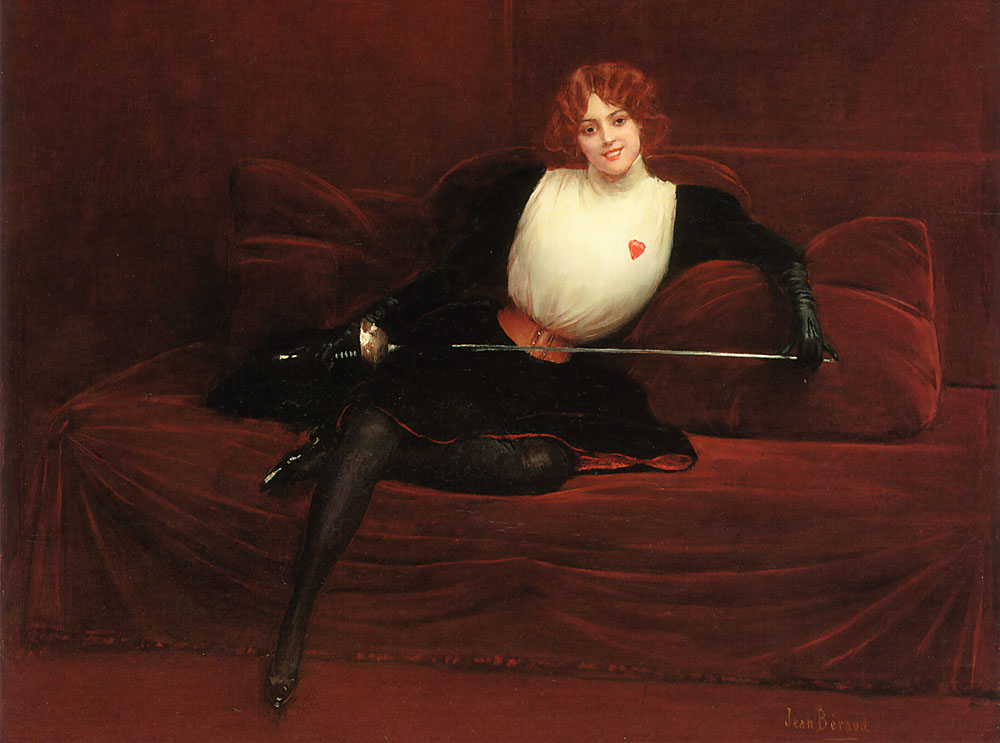
Why is creativity important in fencing, and how come it shuts down when we are under stress? And what has that got to do with making sure you have waxed your moustache before facing mortal danger on the battlefield?
Creativity is what we call the ability to create something new. Some time ago I watched a lecture by Dr. Örjan de Manzano(1). Dr. Manzano’s research shows that highly creative people who do well on divergent tests have a lower density of dopamine D2 receptors in the thalamus compared with less creative people. This means that they don’t filter as much information as normal people and thereby make more unexpected connections.
Most people are familiar with how an IQ test works. It usually contains a problem with a single correct answer. A divergent test is a creativity test that is different from an IQ test because there are no right answers. Instead it tests how quickly you can come up with many answers, how diverse those answers are, and how relevant they are. An example of this would be an examiner handing you an object, for example, a thermometer, and giving you one minute to come up with as many applications for that thermometer as possible. If you can come up with a lot ofcompletely different applications that are relevant, then you are displaying creative thinking skills (e.g. you can use it as a bookmark, to tap on a window, as a knitting needle, to poke someone in the eye, etc.). If you come up with very few applications that are also similar (e.g. checking the temperature in different things) then you are probably not very creative. Or if your answers are diverse but unrealistic (e.g. use it to travel to the moon, to make carpets fly, or to drive as a car), you may be imaginative, but not necessarily creative.
In other words, creativity means that your brain is good at making connections between different things that aren’t related. Or rather, according to Dr. Manzano, it is actually bad at filtering and boxing in information.
What has this got to do with fencing? The ability to come up with viable solutions to a fencing situation on the fly means that you are applying a kind of creativity. Now, just being creative won’t do you any good, because there is also a connection between knowledge and creativity.
It’s easiest to see this connection by looking at innovations. Take any given invention and you will find that it is a result of previously known innovations. The wheel, for example, is the combination of a circular object attached to something through a hole in the middle so that it can spin. In order to invent it you have to be able to make both circular objects and holes. If you take a sailboat, then you are connecting the invention of a boat with the invention of a sail. Creativity is the talent to make the connection between two (or more) previously existing things that you have knowledge about. Thus, knowledge and creativity are both important.
If we translate this to fencing, then reading manuscripts will give you knowledge. Applied knowledge is the same thing as experience, which is key in determining if an action is realistic. Examining it from this angle, creativity is really what gives an edge to the experienced fencer. It is what takes experience and knowledge to the next level. It is also what makes fencing extraordinary.
But seriously, does this really apply?

Fredrik Hären(2), a well-known Swedish writer and lecturer on creativity, tells the story about one of the fathers of modern creativity, J. P. Guilford, creator of the divergent test. During World War II Guilford created tests to select fighter pilots. Later in his life he described that he had been disappointed that there was also a retired air force pilot to help in the selection. When comparing results, Guilford’s pilots had been killed to a much higher degree than those picked by the retired veteran. He was devastated and asked how the pilot had selected them.
The old pilot had asked one question: “What would you do if your plane was shot at by German anti-aircraft?” Anyone who gave the correct answer according to the rulebook, which was to fly higher, was ruled out. Those who said they’d dive, roll, or zigzag were selected. The retired pilot chose his candidates from the group that answered incorrectly because those who follow a rulebook are predictable. According to Hären, Guilford realized that it was a talent to be able to think differently, unexpectedly, and creatively. He then tried to find a way to select pilots who were creative and could improvise and come up with unexpected solutions.
I believe this is also true for fencing.
Creativity goes out the window when under stress
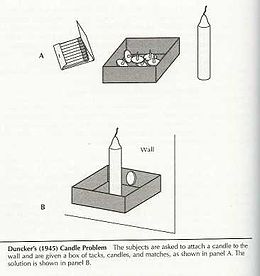
But there is a crux. Creativity means that you are thinking laterally(3), that you have a wide horizon, so to speak. Unfortunately stress narrows that horizon. Let me explain this using another example of a test.
In 1962 two test groups were charged with solving Duncker’s candle problem(4). Duncker’s candle problem is usually solved in a few minutes, and it tests the ability to use an object in a new way, meaning it’s basically a type of creativity test.
However in this case, one of the test groups was told that they could win money if they solved the test quickly. The other group didn’t stand to win any money. The surprising result was that those who could win money did significantly worse, and it took them longer to solve the problem. One explanation for this is that the competitive aspect of the test stressed them.
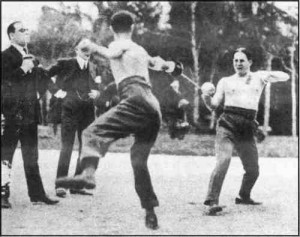
This stress triggered a fight-or-flight response, giving them tunnel vision and shutting down their creative thinking. Even such a simple reward increased their stress level to have a significantly negative impact on the result.
The test showed that rewards boost motivation, which may increase
performance for very simple tasks, but it doesn’t improve performance for creative or complex things because of the stress involved. The reason for the stress is that there is a discharge of hormones in the sympathetic nervous system. The evolutionary explanation for it is that you stand a better chance of survival if you react quickly and automatically, rather than evaluating all options. In other words, your decision-making abilities are being drastically minimised.
Behavioural loops in life and death situations
Sgt Rory Miller brings up an example of this from a martial viewpoint in his book Meditations On Violence (5). He calls it behavioural looping, wherein a person will focus on a technique that is not working and repeat it. It is an extreme form of the shutdown of lateral thinking. He refers to the killing of Deputy Kyle Dinkheller, caught by a police dashboard camera. In the video, which is used to train police in the U.S., you can see that Deputy Dinkheller is frozen in a verbal loop of telling Vietnam veteran Andrew Brannan to “stop that” as Brannan gets an automatic rifle, loads it, cocks it, fires, and even reloads. Dinkheller had plenty of time to react. He could have shot Brannan early on, but instead he repeated the same behaviour and was finally killed. Asked why he had killed Dinkheller, Brannan replied, “Because he let me.”
Miller’s explanation for this is that in such a stressful situation we tend to stick to what has been working so far. Up until he gets shot, Dinkheller hadn’t been shot, so the use of a verbal command to disarm had heretofore worked for him. For an outsider it’s obvious that he should have taken a different approach early on, but since his lateral thinking had shut down, he simply couldn’t bring himself to do something differently, even as the situation escalated towards an obvious conclusion. That cost him his life.
However, as noted in the candle test, it doesn’t have to be a life and death situation to provoke a stressed response. Anything that raises the stakes for you can lead to a cocktail of performance-damaging substances released into your body. When the stakes are high, people tend to do a lot worse than under normal circumstances. This is something that we see quite clearly in competitions. I am myself particularly vulnerable to this. I have in numerous tournaments fenced an opponent in a way that doesn’t work. Instead of trying something new, I repeat the same thing, only faster and harder. I get stuck in bad fencing, and I cannot apply the creativity that I have at my disposal when sparring. It’s worth mentioning a distinction here that is important: sparring is a pressure test against an uncooperative opponent, not a stress test. Most of us do it so often that we are no longer exposed to the chemical cocktail that a more extreme situation will bring us. To be clear, I have lost matches to people who I can beat without breaking a sweat in sparring, but my inability to perform well under stress means that I am lacking essential martial fencing skills. So, even if I may be technically better than my opponent, he is still the better fencer. Understanding this is key to understanding fencing and what it really means.
The role of tournaments
At this point I think it would be good to briefly talk about the role of tournaments, especially since their purpose often is misunderstood. Some people make the mistake of thinking that fencers stick to simple techniques because they “want to win.” That is not the reason. They stick to simple techniques because that is the only thing they dare to do when they risk something. Tournaments are actually a lot more stressful than some outsiders seem to understand, especially tournaments that have an audience.

When you simultaneously argue that tournament fencing should be more controlled, artful, and contain more techniques, while at the same time criticizing tournament fencers for not having a martial approach because “tournaments aren’t like a real fight”, it becomes obvious that you are missing the point. Tournament fencing is often less artistic because there is more at stake, in the same way that real fighting is less artistic than sparring because there is more at stake.
There are many reasons to hold and fight in a tournament (and the different purposes should be reflected in the rules). But one of the overarching reasons for all tournaments is that it provides a stressful testing ground against unknown fencers. That does not exclude other formats of stress testing. In my mind people should try to do as many different stress tests as possible. The more comfortable they become at fighting with high stakes, the easier it will become for them to do the mental transition into a more martial mind-set. Competitions are, and always have been, a way of preparing yourself for the real deal. They are not a simulation of the real deal.
Let me also point out that comfort zones are personal. A competition may be stressful to some, but a walk in the park for others. If you already feel completely at home in the competitive environment, then maybe it’s time to raise the stakes. That doesn’t mean that competitions are bad for everyone. I believe that there are many valuable pursuits for people to train themselves in handling stress, but the important thing is that they do it and get out of their comfort zones.
So how can we train creativity in stressful fencing?
So, how can we learn to handle stress and still be creative? The simple answer is to not be stressed even when the stakes are high. The way to learn that is, as I have already mentioned, to expose yourself to stressful situations so that you get accustomed to them.
Having said that, training will never be the same thing as the real thing, so you will never know exactly how you will react to a life-or-death situation until you have experienced one. However, if you learn how to handle stress in general, you have better odds at controlling your fears when it’s a real situation.
When you experience stress, there are different exercises that you can use to tell the body that it is calm (I will provide one at the end, but to be honest I am still experimenting with this myself). These types of exercises work poorly for situations where you are caught off-guard, for example when you are attacked on the street, but they can actually help you cope with a situation that you are prepared for (but unaccustomed to), for example a tournament, a judicial duel, or a battle. By presenting yourself to a dangerous or stressful situation and controlling your external expressions of stress and fear, you can minimise their effect. The body is sending out signals that it is preparing for flight-or-fight. But by taking control over those signals, you can reverse some of their effect.
So, what are typical symptoms of fear and anxiety? There are many, but some of the most common are:
- Elevated pulse
- Shallow and rapid breathing
- Quick and twitchy movements
- Fidgeting
- Clenched mouth
- Wide eyes and nostrils
- Mind racing
- Drumming fingers and legs
- Nervous talk
- Aggressiveness
By mimicking non-stressed behaviour, for example by breathing deeply and calmly, relaxing your muscles, relaxing the jaw etc. you can influence the stress level. In a sense you are tricking the body into thinking that the situation is less stressful, and you can thereby gain access to your lateral thinking. Over time, as you have faced many such situations, your mind will get accustomed to it, and the impact will be smaller. Then it will be time to up the stakes.
However, when the mind is excited by some more violent fear we observe that the entire soul shows fellow feeling in every member. Sweat and pallor appear in every part of the body, the tongue falters, the voice miscarries, the eyes mist over, the ears ring, the limbs give way. In fact, we often see men collapse from terror in the mind. From this, one may readily realize that soul and mind are conjoined, for when the soul is dealt a forceful blow by the mind it forthwith thrusts into the body and activates it.
Epicurus 341 BC – 270 BC, Letter to Herodotus
Martial cultures
These signs of stress are natural, and most martial cultures have approaches to deal with them in order to lessen their effect. Mensur fencing is a perfect example, designed to let you test how well you can handle a situation where you run a high risk of being disfigured. In training and in the social context surrounding the mensur, you learn to control yourself, and to force yourself to neither flinch nor show signs of emotions.
The English stiff upper lip is also an expression of this type of martial training. You have a social pressure, as well as actual training, to endure hardships without showing signs of pain or fear. When you present yourself for the battlefield you do it as if it means nothing to you, with your clothes in order and your moustache waxed. In doing so you tell yourself and others around you that you are calm and relaxed.
I believe this is something that we can learn from and that it is an approach that leads to martial insights. Just like martial cultures with various types of dangerous rites of passages, we must push ourselves to do things that are outside of our comfort zone and do our best to keep our composure.
A fencer’s behaviour and conduct
In tournaments and other gatherings it’s important that we also address these issues if we want them to be tests of a fencer’s ability. A competition should, just like mensur fencing, be a test of a fencer’s personality and composure. It’s an opportunity to show composure when facing violence. Some of this behaviour can be formulated as actual rules, but more importantly is the culture for how we carry ourselves.
In my opinion, I think a fencer should control his emotions in both victory and defeat. Always greet other fencers respectfully. Congratulate a winner and show respect to the defeated. A fencer should carry him or herself with composure and avoid screaming, making involuntary noises or gestures, and be distinct in movement. A fencer should also respect the sword and what it represents, which means you don’t throw it, and you do not game the rules in order to win. You accept that a hit by a sword is something that represents injury or death, and you accept and reflect upon the fact that what you do is a preparation for combat where your life is at stake.
Take control over your reactions
To finish things off, here is a method that you can use to take control over your anxiety in a stressful situation, for example before entering the arena to fence.
- Accept your fear and let it in. Let it flow over you and simply observe what it does to you. Watch the bodily and mental signs of it. How is your breathing, are your palms sweaty, are you fidgeting, is your mind trying to give you excuses to give up?
- Put a number on it from 1 to 10.
- Take control over your reactions, and counter them by forcing yourself to normal behaviour. Take control over your breathing by inhaling for 7 seconds and exhaling for 10. Relax your muscles. Relax your face. Smile.
- Act normally and carry on as if you were on your everyday business. Apply decorum of behaviour that is suitable for a fencer.
- Now put a number on your stress level. And repeat if necessary.
THANK YOU!
Meg Floyd for proofreading and making the text readable.


